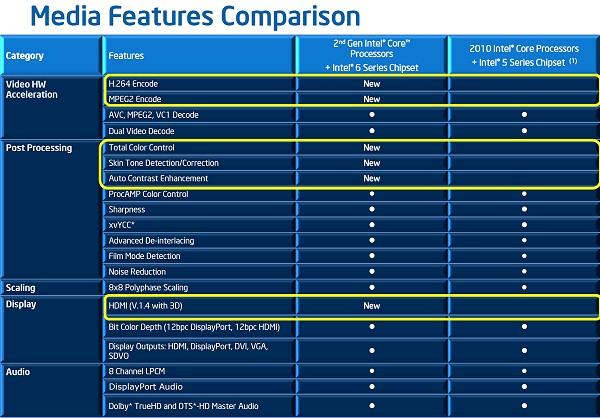2nd Gen Intel HD Graphics
Intel claims Sandy Bridge processors are up to 42% faster for content creation and 50% faster in games compared to Westmere-based chips. This is perhaps the single largest performance improvement you will hear about when comparing these architectures and essentially it has nothing to do with the CPU itself, but rather the integrated graphics engine.
When looking at the previous generation Westmere chips, it was easy to pinpoint that the graphics engine didn't really belong and it was more of a transitional product. These chips used an on-package graphics engine that was separate from the CPU. Furthermore, it was built using the 45nm process and not the same 32nm process used by the actual CPU. The redesigned Sandy Bridge architecture on the other hand includes the GPU on-die, meaning that it's also built using the same 32nm process as the CPU.

Even though both are now under the same roof, the GPU is still very independent of the CPU. It features its own clock domain, meaning that it can be clocked independently and can be powered down as needed.
There are two versions of the Intel HD Graphics used by the Sandy Bridge processors, known simply as the 2000 and 3000. They each feature fourth generation Unified Shader Architecture, Dedicated Math box and Media Processing.
They can be clocked up as high as 1350MHz and support a maximum resolution of 2560x1600. Rendering support includes DirextX 10.1, OpenGL 3.0 and Shader Model Support 4.1. In contrast, the previous generation supported DirectX 10, OpenGL 2.1 and SM 4.0, while operating frequencies only reached the 900MHz mark.

The shaders, cores and execution units are what Intel calls EUs (Execution Units) with HD Graphics 2000 featuring six and the speedier HD Graphics 3000 getting twelve. Interestingly only some desktop processors in the Core i3 and Core i5 series use the slower HD Graphics 2000 engine, while all mobile processors receive the 3000 engine. However with a two-fold throughput increase per EU, even the HD Graphics 2000 engine should outperform the GMA HD engine of the Westmere architecture.